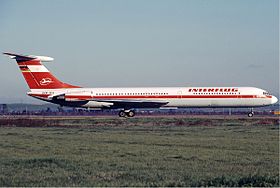Interflug flight 102
| Interflug flight 102 | |
|---|---|
|
A structurally identical Interflug aircraft. |
|
| Accident summary | |
| Accident type | Overshooting the runway |
| place | Berlin Schönefeld Airport |
| date | June 17, 1989 |
| Fatalities | 21st |
| Survivors | 92 |
| Aircraft | |
| Aircraft type | Ilyushin Il-62M |
| operator | Interflug |
| Mark | DDR-SEW |
| Passengers | 103 |
| crew | 10 |
| Lists of aviation accidents | |
On 17th June 1989 a rolled airliner type Ilyushin Il-62M at the start of the runway in Berlin also, crashed and caught fire. Flight IF 102 of Interflug , the national airline of the German Democratic Republic , had 103 passengers and 10 crew members. The cause of the aborted take-off was a blocked elevator.
procedure
The machine with the aircraft registration DDR-SEW (serial number 2850324) was only one year old when it was supposed to take off from Berlin-Schönefeld airport on the morning of June 17, 1989, a Saturday, with a low load at around 8:15 . There were 103 passengers and 10 crew members on board. The destination of flight IF 102 was Moscow .
The start took place at 8:28 a.m. When the pilots found that the elevator was blocked when they reached take-off speed, they were forced to abort take-off after 40 seconds. Instead of setting the engines to idle and then setting the outer engines to reverse thrust , the flight engineer accidentally switched the engines off. This led to the fact that the machine no longer came to a standstill on the runway, but touched the course antenna of the instrument landing system behind the end of the runway and collided with street trees and a water tank lying on the edge of the field. The aircraft did not come to a stop about 500 m behind the runway, broke apart and caught fire.
Before the hull went up in flames, almost 100 of the occupants were able to get outside through emergency exits and torn open areas.
root cause
The cause of the accident was a faulty design of the elevator of the Ilyushin Il-62 known to the manufacturer, for example Aeroflot and the NVA, but not communicated within Interflug. The corresponding warning signals in the cockpit had not worked.
According to the expert, the collision after leaving the runway could have been avoided by the correct reaction of the engineer. In a court case on November 5, 1997, the flight engineer was acquitted of the charge of negligent homicide.
Rescuing the passengers
Disaster management at the airfield failed that day. A lot of time passed between the accident and the arrival of the first aid workers. For example, the situation was only actually recognized in the apron control after more than ten minutes. Up to this point in time, the employees in the airport building assumed that the aircraft would roll back to its apron due to a technical defect and that the passengers should get off there. Valuable time passed before the first airport employees etc. a. could take the apron buses to the end of the runway. These bus drivers were the first on-site helpers. An estimated 20 minutes after the accident, the first passengers, some of whom were seriously injured, were on the buses. No ambulance, no fire brigade, no doctor were on site at this time. Instructions to the drivers as to where the injured were to be taken were omitted. A bus driver with around 20 people on board then drove to the Hedwigshöhe hospital in Berlin-Bohnsdorf, ten kilometers away . The first ambulances only arrived at the scene of the accident afterwards.
Most of the ambulances of the GDR rescue service Rapid Medical Aid came from hospitals in East Berlin up to 30 km away.
15 people died at the scene of the accident, two on the transport and four later in the hospital. All victims could be identified.
literature
- Interflug process in May , In: Berliner Zeitung , April 16, 1997
- Never dealt with - June 1989: Air disaster in Schönefeld , In: Der Tagesspiegel , June 16, 2009
Individual evidence
- ^ Accident report IL-62M DDR-SEW , Aviation Safety Network (English), accessed on January 26, 2019.
- ↑ http://zefys.staatsbibliothek-berlin.de/ddr-presse/view1/?purl=SNP26120215-19890619-0-1-0-0
- ↑ Expert: Security deficiencies at Interflug . In: Berliner Zeitung , November 1, 1997
- ↑ Interflug's flight engineer acquitted . In: Berliner Zeitung , November 6, 1997
